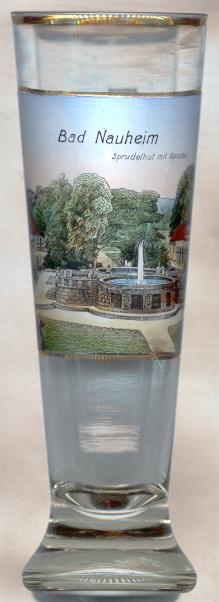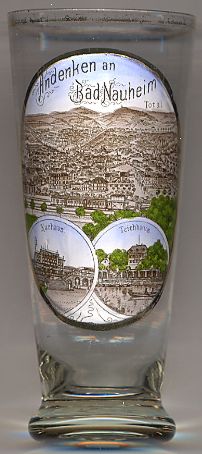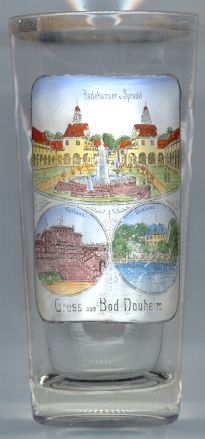

|
| DEUTSCHLAND | GERMANY |
| Bundesland: Hessen | Hesse |
| Regierungsbezirk: Darmstadt | |
| Kreis: Wetteraukreis |
 Bad Nauheim is situated at an elevation of 144 m at the foot of the Johannisberg (268 m) at the foothills of the Taunus mountain region.
The saline springs of Bad Nauheim already had been used by the celtic inhabitants of the region in the 5th century BC. The settlement Niwiheim was founded around AD 500.
From the on the production of salt dominated the development of the place. At the beginning of the 19th century, the saline waters started to be used for therapeutic purposes.
At first, the waters were sold to Wilhelmsbad and Hanau, but soon after that, the first spa bath of Nauheim was opened in 1835.
The place received the status of a town in 1854. The predicate Bad (spa) was awarded in 1869.
During the following years, Bad Nauheim became one of the most populars spas in Europe. Among the numerous famous guests were
Empress Elisabeth of Austria, Empress Alexandra of Russia and Empress Auguste-Viktoria of Germany.
Bad Nauheim is situated at an elevation of 144 m at the foot of the Johannisberg (268 m) at the foothills of the Taunus mountain region.
The saline springs of Bad Nauheim already had been used by the celtic inhabitants of the region in the 5th century BC. The settlement Niwiheim was founded around AD 500.
From the on the production of salt dominated the development of the place. At the beginning of the 19th century, the saline waters started to be used for therapeutic purposes.
At first, the waters were sold to Wilhelmsbad and Hanau, but soon after that, the first spa bath of Nauheim was opened in 1835.
The place received the status of a town in 1854. The predicate Bad (spa) was awarded in 1869.
During the following years, Bad Nauheim became one of the most populars spas in Europe. Among the numerous famous guests were
Empress Elisabeth of Austria, Empress Alexandra of Russia and Empress Auguste-Viktoria of Germany.
The spring  Großer Sprudel [left, no. 959] broke forth in 1846 and secured the development as a spa.
Further springs broke forth in 1855 and in 1900 (Friedrich-Wilhelm-Sprudel and Ernst-Ludwig-Sprudel). The water basins of the springs were built in 1911/12.
Großer Sprudel [left, no. 959] broke forth in 1846 and secured the development as a spa.
Further springs broke forth in 1855 and in 1900 (Friedrich-Wilhelm-Sprudel and Ernst-Ludwig-Sprudel). The water basins of the springs were built in 1911/12.


The  Kurhaus [right, no. 1049: bottom left] was built in 1864–1866.
The terrace was enlarged in 1905–1910.
Kurhaus [right, no. 1049: bottom left] was built in 1864–1866.
The terrace was enlarged in 1905–1910.
The  new spa facilities in Art Nouveau style [right, no. 1049: top]
were added in 1905–1912 to accomodate the guests arriving from all over Europe and America. The group of buildings is one of the largest ensemble of art nouveau
constructions in Germany.
new spa facilities in Art Nouveau style [right, no. 1049: top]
were added in 1905–1912 to accomodate the guests arriving from all over Europe and America. The group of buildings is one of the largest ensemble of art nouveau
constructions in Germany.
The  Teichhaus-Schlösschen (pond château) [right, no. 1049: bottom right] dates back to 1780.
It was remodelled in 1900/11. During the 20th century it fell into dereliction. After a renovation in 1995 it is in use as a café and restaurant again.
Teichhaus-Schlösschen (pond château) [right, no. 1049: bottom right] dates back to 1780.
It was remodelled in 1900/11. During the 20th century it fell into dereliction. After a renovation in 1995 it is in use as a café and restaurant again.
![[scale]](lineal.jpg)